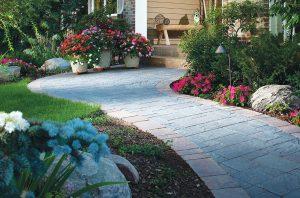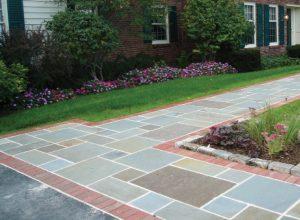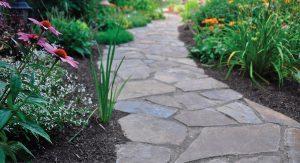 If you are familiar with the history of European art during the Renaissance period, you may have heard of the theory of linear perspective. This theory shows that objects appear smaller as their distance from the observer increases. You can apply this theory when landscaping your yard by adding a walkway. A path can direct the eye and convince the viewer the yard is larger. Adding a pathway to your yard has many benefits including added convenience and a firm surface around an outdoor living space. Paths are often low maintenance as well. Despite these benefits, the importance of a path often gets overlooked. Without a path, your space can become disjointed because of the lack of thought put into the transitions and connections between different areas. A path also provides an opportunity to show your personal style in your yard. Like choosing interior flooring, there are lots of options to take into consideration like paving materials and design style. This article provides suggestions for paving materials and design styles that might work best for you.
If you are familiar with the history of European art during the Renaissance period, you may have heard of the theory of linear perspective. This theory shows that objects appear smaller as their distance from the observer increases. You can apply this theory when landscaping your yard by adding a walkway. A path can direct the eye and convince the viewer the yard is larger. Adding a pathway to your yard has many benefits including added convenience and a firm surface around an outdoor living space. Paths are often low maintenance as well. Despite these benefits, the importance of a path often gets overlooked. Without a path, your space can become disjointed because of the lack of thought put into the transitions and connections between different areas. A path also provides an opportunity to show your personal style in your yard. Like choosing interior flooring, there are lots of options to take into consideration like paving materials and design style. This article provides suggestions for paving materials and design styles that might work best for you.
Selecting paving materials
The choice of paving material could be the most important decision in building a path in your yard. Different paving materials can add color, texture, and individualized pattern designs and contribute to the style and mood. Unlike the selection of plants or furniture, selecting the right material for your yard is crucial because the effect is long-lasting. The number of choices can be a bit overwhelming. However, if you start by exploring the options in categories, the decision will seem less intimidating.
 Quarried stone–stepping stones: Just like its literal meaning, quarried stone is dug from the ground and then shaped by splitting, cutting, or crushing. If you like nature, quarried stones may be a suitable option for you since they are practical and suited to the environment. Limestone, granite, sandstone and slate are the most common types of quarried stones. You can choose your favorite one to make a path of stepping stones. Stepping stones work perfectly on flat planes of grass or gravel and are easy to maintain because the stones can be mowed over. Creating a path with stepping stones is simple and can inspire you to enjoy your journey from one side of your yard to another. You don’t even need to struggle with the size and shape of the stones. Random sizes work as long as the color and design fit your landscape. In other words, stepping stones are the fastest and easiest way to build a path because there is very little digging involved and its cost depends on the distance between stones. The distance between each stone is important because the grass and weeds may overtake the walkway if there is too much space between stones. While the distance required is unique to the people using the path, the average distance between stones is eighteen to twenty-four inches, which refers to the average person’s stride. You can also try to mix the scales by reducing the distance between pavers as they extend toward the back of the yard. This trick will create the impression of distance in your yard.
Quarried stone–stepping stones: Just like its literal meaning, quarried stone is dug from the ground and then shaped by splitting, cutting, or crushing. If you like nature, quarried stones may be a suitable option for you since they are practical and suited to the environment. Limestone, granite, sandstone and slate are the most common types of quarried stones. You can choose your favorite one to make a path of stepping stones. Stepping stones work perfectly on flat planes of grass or gravel and are easy to maintain because the stones can be mowed over. Creating a path with stepping stones is simple and can inspire you to enjoy your journey from one side of your yard to another. You don’t even need to struggle with the size and shape of the stones. Random sizes work as long as the color and design fit your landscape. In other words, stepping stones are the fastest and easiest way to build a path because there is very little digging involved and its cost depends on the distance between stones. The distance between each stone is important because the grass and weeds may overtake the walkway if there is too much space between stones. While the distance required is unique to the people using the path, the average distance between stones is eighteen to twenty-four inches, which refers to the average person’s stride. You can also try to mix the scales by reducing the distance between pavers as they extend toward the back of the yard. This trick will create the impression of distance in your yard.
 Composite material–boardwalk: Composite materials like brick, precast concrete pavers and wood are processed and molded to have unique qualities. Composites can offer a greater degree of flexibility and are easier to install than stone. Because the path is liable to be the most lasting and influential element in your yard, you may want to consider the color, texture, and style of the surrounding area such as plants, fixtures, and other structures. If you are looking for an easy and inexpensive path, a wooden walkway is the best choice. It does not require a lot of digging to install compared to other materials such as stone and other similar pavers, which helps you save time and money. It is such a simple project that you can even build in sections as you have time. Considering the benefits, this is a wise starting point because you can see the difference in lighting and positions before you commit to the entire project. Building with wood is easy, fast and suitable for wet and sloping areas. For example, a forty-foot walkway topped with cedar decking will take only around two days and four hundred dollars. More importantly, a long and thin boardwalk leads the eye into the distance and creates the illusion that the space is longer than it actually is. Also, think about the principle of parallel lines. As the decking recedes, the slats appear to get narrower. They will appear to meet at a “vanishing point,” and objects in the distance appear smaller than those close by, making a small yard seem larger.
Composite material–boardwalk: Composite materials like brick, precast concrete pavers and wood are processed and molded to have unique qualities. Composites can offer a greater degree of flexibility and are easier to install than stone. Because the path is liable to be the most lasting and influential element in your yard, you may want to consider the color, texture, and style of the surrounding area such as plants, fixtures, and other structures. If you are looking for an easy and inexpensive path, a wooden walkway is the best choice. It does not require a lot of digging to install compared to other materials such as stone and other similar pavers, which helps you save time and money. It is such a simple project that you can even build in sections as you have time. Considering the benefits, this is a wise starting point because you can see the difference in lighting and positions before you commit to the entire project. Building with wood is easy, fast and suitable for wet and sloping areas. For example, a forty-foot walkway topped with cedar decking will take only around two days and four hundred dollars. More importantly, a long and thin boardwalk leads the eye into the distance and creates the illusion that the space is longer than it actually is. Also, think about the principle of parallel lines. As the decking recedes, the slats appear to get narrower. They will appear to meet at a “vanishing point,” and objects in the distance appear smaller than those close by, making a small yard seem larger.
 Mixed materials: Choosing mixed materials is a great way to show your personality while saving you money at the same time. A collection of different paving materials provides a range of patterns and textures beyond anything you could complete with a single type of stone or composite. There is no restriction for the material selection. You can choose anything from a row of brick and stone to a brick or granite border, depending on your preference. You can combine brick and stone to create a patchwork-quilt path, or you can accent bricks on your curving stone path. You can also outline your path with bricks and place diamond stepping stones down the center with gravel surrounding the diamonds for a stylish look. Mixed-material paths needn’t be complex; it is all based on your imagination.
Mixed materials: Choosing mixed materials is a great way to show your personality while saving you money at the same time. A collection of different paving materials provides a range of patterns and textures beyond anything you could complete with a single type of stone or composite. There is no restriction for the material selection. You can choose anything from a row of brick and stone to a brick or granite border, depending on your preference. You can combine brick and stone to create a patchwork-quilt path, or you can accent bricks on your curving stone path. You can also outline your path with bricks and place diamond stepping stones down the center with gravel surrounding the diamonds for a stylish look. Mixed-material paths needn’t be complex; it is all based on your imagination.
Paving style
From a practical standpoint, you don’t have to upend the backyard and start over. A small change can help you bring your yard to life. Simply focus on the details. If you want to upgrade the appearance of your yard, you only need to add some nice complements based on what you have now. Considering these small investments I listed below will help your yard look interesting and be multifunctional.
Split the spaces: A path not only serves as an eye-catching design piece, but it also provides a functional way to separate the space, creating a feel of even more distinct areas. If you are feeling creative, you can make your backyard look wider by applying paving materials that stand out from their surroundings in order to highlight the edges. Also, the combination of several small areas can make your space feel larger than a single medium-sized area. For example, you can turn your patio into two small spaces by creating a path in the middle. The path will draw the eye through the space and create the illusion that the area has doubled in size.
 Enhance your path: Considering the linear perspective, designing your path diagonally or along an S-curve will allow the space to unfold gradually rather than in a single glance, making your yard appear bigger. You can increase the breadth of an existing path in your yard for an effective way to make an impact and make short distances seem longer. Modifying your existing path to create a curved or zigzag configuration gives the impression that the yard is wider and adds a sense of mystery. Paths that curve out of sight behind planters lead the eye to move from side to side and invite exploration. You should also include a visual reward at the back of curving paths by carefully placing plants. Color can also be a great way to change the perception of depth. For example, you can plant intense, bright and warm-colored plants at the front of your path and cooler and deeper tones such as blues and purples toward the back as the distance increases. The colorful plants serve as a focal point in the middle to draw your eyes forward and advance toward the front of the path while cooler tones in the corner or the back will recede. On the other hand, you can consider doubling or tripling the size of your existing path because an extra-wide walkway not only visually stretches the small yard but also creates more living space and relieves you from lawn chores.
Enhance your path: Considering the linear perspective, designing your path diagonally or along an S-curve will allow the space to unfold gradually rather than in a single glance, making your yard appear bigger. You can increase the breadth of an existing path in your yard for an effective way to make an impact and make short distances seem longer. Modifying your existing path to create a curved or zigzag configuration gives the impression that the yard is wider and adds a sense of mystery. Paths that curve out of sight behind planters lead the eye to move from side to side and invite exploration. You should also include a visual reward at the back of curving paths by carefully placing plants. Color can also be a great way to change the perception of depth. For example, you can plant intense, bright and warm-colored plants at the front of your path and cooler and deeper tones such as blues and purples toward the back as the distance increases. The colorful plants serve as a focal point in the middle to draw your eyes forward and advance toward the front of the path while cooler tones in the corner or the back will recede. On the other hand, you can consider doubling or tripling the size of your existing path because an extra-wide walkway not only visually stretches the small yard but also creates more living space and relieves you from lawn chores.
Intensify the illusion: To emphasize the linear perspective, you can add visible connections on your path or include interesting elements along the path. For example, include more visible joints on the front of the path and gradually decrease the visibility of the joints at the end of the path. You can also create a focal point at the front of the path and include a scaled-down feature at the end. A focal point will catch your eye’s attention and make your yard look more interesting. For example, using big containers full of impatiens, fuchsias, or petunias, you can highlight specific areas along the path. These accent containers bring life year round and are easy to move around. More importantly, these fragrant plants accent the scene, invite exploration and screen unwanted views. One thing you need to consider is the color for those group pots because it’s best to choose one main color along with harmonizing hues to avoid distracting the eye. You should also consider the color rules about bright and dark tones I mentioned in the previous section.
A good walkway not only tells you and your guests where to walk, but it also represents your personality and sets the mood for the landscape. Whether you try applying the linear perspective with your path to make your yard appear longer or get inspired by these material suggestions, use these tips to make your space your own. Now that you know the options of paving materials and some design aspects, I hope you enjoy making your yard a piece of contemporary art and appreciate the unique and roomy space you create. ![]()
Ning Qin
Home & Yard Magazine




